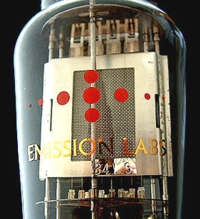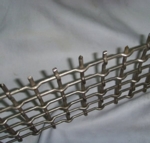EML45 'Mesh' Information Only
For Data sheet, use EML45
 |
For general information, we refer to the data sheet of the 45 'Solid Plate'. |
History of the 45
For keeping the original sound character of this tube, we have chosen for V-shaped filaments.
The 2A3 can be called the big brother of the 45, designed by RCA. The 2A3 and 45 differ not only in size, but also the 45 has a V-Shape of it's filaments, whereas the 2A3 does not have this. The V-shaped filaments will give a different electrical field inside the tube. Though the influence of this on the sound is not large, it is still characteristic for the 45 tube.
The wire mesh we use, is very soft, in order to achieve the mechanical damping properties. It would be too soft to make the entire anode of mesh wire, but we have solved this problem by using a mesh window. The window size is larger than the filaments, and the solid part of the anode, serves now the cooling, while keeping the anode distance constant. An anode of wire mesh only, would expand due ti heat, and then change it's distance, and by this the electrical bias.
What is a wire mesh?
In the English dictionary, 'mesh wire' is described as woven metal wire. Some sellers fool the buyer with a many tiny punched holes in the Anode. They are calling this 'mesh'. A difference which you can see only under magnification. Read here for a warning information.
Mesh window, reasons behind it
The frame of the wire mesh window, is also internally covered with mesh, in order to prevent a sudden change of anode distance inside the Anodes, at the position where the wire mesh window ends. Like this, we can use the wire mesh window, and keep the electrical properties of the 45 unchanged. Also, this construction makes the tube shock proof to a great extend, and the typical shipment damage problems as with historical mesh wire tubes, will not occur with EML.This construction gives not only a pleasant sounding tube,. It appeared later, this stands also for exceptional long lifetime. We have reason to believe, it is outdoing the lifetime of NOS tubes by a multiple factor. (Read the article on the right side of this page)
Sound character
Please also read the data sheet of the regular 45, as this information applies for the 45 mesh version as well.
Influence of mesh on the sound
 Mesh wire has a very high mechanical damping factor due to friction, if the wire crossings are not mechanically connected to to each other. This friction avoids resonance effects. It is even used as damping system in instruments. In the factory we can investigate the loose anodes. If you knock on such a Solid Plate anode, there will be a bell sound, because nickel is a very hard metal. If you knock on a mesh anode, there will be no ringing, as the damping function of the wire mesh will do it's job. This is insofar the only mechanical proof we have found for the difference in sound.
Mesh wire has a very high mechanical damping factor due to friction, if the wire crossings are not mechanically connected to to each other. This friction avoids resonance effects. It is even used as damping system in instruments. In the factory we can investigate the loose anodes. If you knock on such a Solid Plate anode, there will be a bell sound, because nickel is a very hard metal. If you knock on a mesh anode, there will be no ringing, as the damping function of the wire mesh will do it's job. This is insofar the only mechanical proof we have found for the difference in sound.
In addition, there are two elements which are present, of which we assume, they influence sound as well. The surface of the wire mesh is raw, so anode distance is varies with some 7% percent, depending if you look at a wire, or at a crossing. Thousands of those areas are in parallel, and the result is the composite anode as such. Moreover a small percentage of the electrons escape initially through the holes, and returning to the anode at the outside. This is causing a small blue fluorescent effect, and also their electrical path is obviously somewhat different.
The sound difference
We are often asked about this. During hearing tests, an improved sound is confirmed by many listeners worldwide, most of all when using high quality loudspeaker systems, such as horn systems, or head phones. When a tube is given mesh Anodes, something magic happens to the sound. A more transparent sound stage appears in many cases, meaning a more realistic stereo reproduction of the original sound recording. With mesh tubes you will enjoy the very best of what small triodes have to offer.
Higher anode dissipation of the 45 mesh
Though this was not a specific design intention, we have found that the wire mesh version can handle a slightly higher maximum anode dissipation than the standard 45.
EML 45 MESH Maximum Conditions. (Allowed continiously) |
|
| Anode Voltage | 300Volt |
| Anode Current | 45mA |
Maximum Dissipation for new types after 2006. |
13,5 Watt (Note4) |
| Maximum Dissipation for older types from 2006 or before | 11 Watt (Note4) |
| Power Output in Class A | 3.5 Watt |
| Grid resistor, highest possible value (Important: Note5) |
500k Ohm |
EML 45 MESH Typical Data Single Ended |
|||
| Anode Voltage | 250V |
275V |
300V |
| Anode Current | 34mA |
36mA |
39mA |
| Maximum Dissipation | 8.5Watt |
9.9 Watt |
11.7Watt (only possible with mesh tube, or with the new 45B) |
| Control Grid Voltage | 50Volt |
56Volt |
58,6Volt |
| Anode Impedance (Rp) | 1750 Ohm |
1670 Ohm |
1600 Ohm |
| Amplification Factor | 3.5 |
3.5 |
3.5 |
| Transconductance (Gm) | 2mA/V |
2.1mA/V |
2.2mA/V |
| Power Output in Class A | 1.6 Watt |
2 Watt |
2.5 Watt |
| Load Impedance (Ra) | 3900 Ohm |
4600Ohm |
5000-5600 Ohm |
Recommended Singe Ended transformers |
|||
| Primary |
Output |
Remark | |
| FC12S ISO Japan |
5000Ω | 8Ω, 16Ω | This transformer includes already a (beautiful) housing, and easy to use tapped connections. |
| LL1663-040 Lundahl |
5000Ω | 8Ω | Budget transformer. No housing, and only one output impedance. |
| LL1682-050 Lundahl |
5000Ω | 5Ω | Budget transformer. No housing, and only one output impedance. |
| LL2752-060 Lundahl |
4600Ω | Alt.C =8Ω Alt.D =16Ω |
This transformer can be rewired for 8 or 16 Ohms (no taps). The primary is ideal for 275V use. |
Note 4)Historical 45 tubes have a maximum dissipation of 11 Watt, which means the maximum voltage and maximum current can not be applied at the same time. Our new type, (shipped since Q3-2006) has 13,5 Watt maximum dissipation, meaning maximum voltage and maximum current can be applied at the same time.
Note 5) EML45 first generation (from before 2004) and all tubes from before the year 2000, which have the designation on the socket: 'VV45', have a maximum grid resistor value of 100k. Exceeding this value may cause difficulties with tube bias.
Note 6) In a class AB2 amplifier, the tubes are operated mildly into positive Control Control Grid Voltage. Output power as published not tried be exceeded, though this may appear possible, it will damage the grid of historical tubes. The 2nd Harmonics resulting from this, are cancelled by virtue of the Push Pull circuit. A sufficient low impedance driver stage is needed for class AB2. This can be achieved with a step down inter stage transformer, as recommended by the RCA receiving tube manual 1934, Page 93. Please look at the standard '45' data sheet for some examples of Push Pull working points